Polynomial Long Division
In this lesson, I will go over five (5) examples with detailed step-by-step solutions on how to divide polynomials using the long division method. It is very similar to what you did back in elementary when you try to divide large numbers, for instance, you have [latex]1,723 \div 5[/latex]. You would solve it just like below, right?
Quick Review of the Long Division Method of Numbers
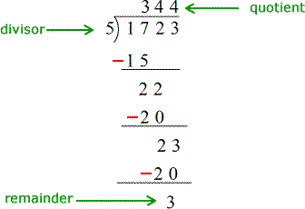
If you can do the simple numerical division by the long method, as shown above, I am convinced that you can do the problems below. The only added thing is the division of variables.
Examples of Dividing Polynomials using the Long Division Method
Example 1: Divide using the long division method

Solution: I need to make sure that both the dividend (stuff being divided) and the divisor are in the standard form. A polynomial in standard form guarantees that its exponents are in decreasing order from left to right. Performing a quick check on this helps us to prevent basic avoidable mistakes later on.
By quick examination, I hope you agree that both our dividend and divisor are indeed in standard form. That means we are now ready to perform the procedure.
STEP 1: Consider both the leading terms of the dividend and divisor.
STEP 2: Divide the leading term of the dividend by the leading term of the divisor.
STEP 3: Place the partial quotient on top.
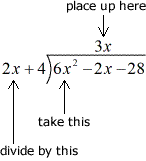
STEP 4: Now take the partial quotient you placed on top, [latex]3x[/latex], and distribute it into the divisor [latex]\left( {2x + 4} \right)[/latex].
STEP 5: Position the product of [latex]\left( {3x} \right)[/latex] and [latex]\left( {2x + 4} \right)[/latex] under the dividend. Make sure to align them by similar terms.
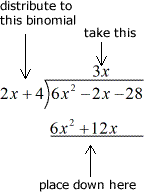
STEP 6: Perform subtraction by switching the signs of the bottom polynomial.

STEP 7: Proceed with regular addition vertically. Notice that the first column from the left cancels each other out. Nice!
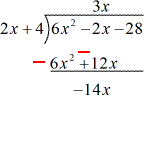
STEP 8: Carry down the next adjacent “unused” term of the dividend.

STEP 9: Next, look at the bottom polynomial, [latex] – 14x – 28[/latex], take its leading term which is [latex] – 14x[/latex] and divide it by the leading term of the divisor, [latex]2x[/latex].
STEP 10: Again, place the partial quotient on top.
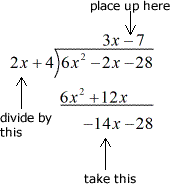
STEP 11: Use the partial quotient that you put up, [latex]-7[/latex], and distribute it into the divisor. Seeing a pattern now?
STEP 12: Place the product of [latex]-7[/latex] and the divisor below as the last line of polynomial entry.
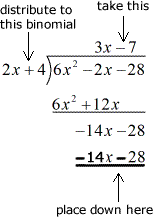
STEP 13: Subtraction means you will switch the signs (in red).

STEP 14: Perform regular addition along the columns of similar terms
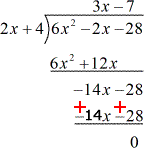
STEP 15: This is great because the remainder is zero. It means the divisor is a factor of the dividend.
The final answer is just the stuff on top of the division symbol.

Example 2: Divide using the long division method

Solution: This problem is also considered “nice” just like the first one because both the dividend and divisor are in standard forms.
This time around you are dividing a polynomial with four terms by a binomial. Remember that example 1 is a division of polynomial with three terms (trinomial) by a binomial. Hopefully, you see a slight difference.
Let’s go ahead and work this out!
STEP 1: Focus on the leftmost terms of both the dividend and divisor.
STEP 2: Divide the leftmost term of the dividend by the leftmost term of the divisor.
STEP 3: Place the partial answer on top.
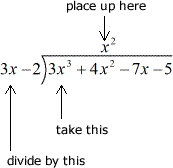
STEP 4: Use that partial answer, [latex]{x^2}[/latex], to multiply into the divisor [latex]\left( {3x – 2} \right)[/latex].
STEP 5: Place their product under the dividend. Make sure to align them by similar terms.
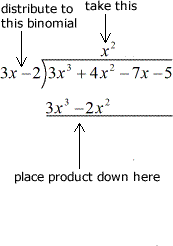
STEP 6: Perform subtraction by alternating the signs of the bottom polynomial.

STEP 7: Proceed with regular addition vertically. Again the first column cancels each other out. Looks like a pattern to me!
STEP 8: Carry down the next adjacent “unused” term of the dividend
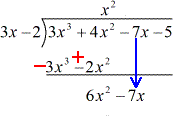
STEP 9: Take the leftmost term of the bottom polynomial, and divide by the leftmost term of the divisor.
STEP 10: Place the answer on top, as usual.
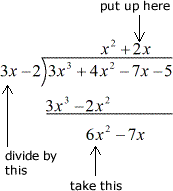
STEP 11: Okay, perform another multiplication by the partial answer [latex]2x[/latex] and divisor [latex]\left( {3x – 2} \right)[/latex]. Bring the product below.
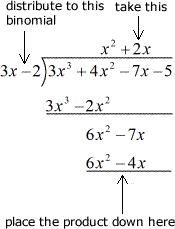
STEP 12: Perform subtraction by switching signs and proceed with normal addition.
STEP 13: Carry down the last unused term of the dividend. We’re almost there!
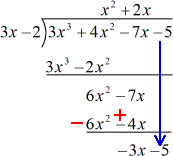
STEP 14: We are going up one more time. Divide the leading term of the bottom polynomial by the leading term of the divisor. Place the answer up there!
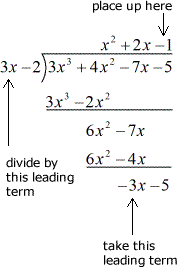
STEP 15: This is our “last trip” going down so we distribute the partial answer [latex]−1[/latex] by the divisor [latex]\left( {3x – 2} \right)[/latex], and place the product “downstairs”.
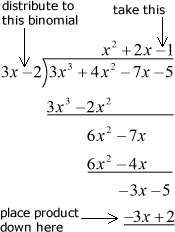
STEP 16: Finish this off by subtraction leaving as with a remainder of [latex]-7[/latex].
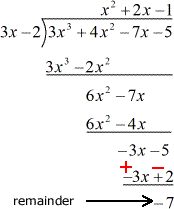
STEP 17: Write the final answer in the following form.


Example 3: Divide using the long division method

Solution: If you observe the dividend, it is missing some powers of variable [latex]x[/latex] which are [latex]{x^3}[/latex] and [latex]{x^2}[/latex]. I need to insert zero coefficients as placeholders for the missing powers of the variable. It is a critical part to correctly apply the procedures in long division.
So I rewrite the original problem as

Now all [latex]x[/latex]’s are accounted for!
STEP 1: Focus on the leading terms inside and outside the division symbol.
STEP 2: Divide the first term of the dividend by the first term of the divisor.
STEP 3: Position the partial answer on top.
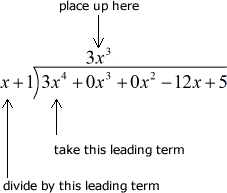
STEP 4: Use that partial answer placed on top, [latex]3{x^2}[/latex] to distribute into the divisor [latex]\left( {x + 1} \right)[/latex].
STEP 5: Put the result under the dividend. Make sure to align them by similar terms.
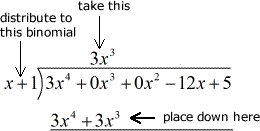
STEP 6: Subtract them together by making sure to switch the signs of the bottom terms before adding.
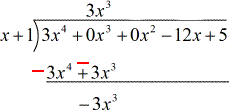
STEP 7: Carry down the next unused term of the dividend.
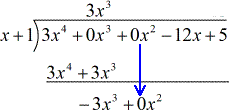
STEP 8: Looking at the bottom polynomial, [latex] – 3{x^3} + 0{x^2}[/latex], use the leading term [latex] – 3{x^3}[/latex] and divide it by the leading term of the divisor, [latex]x[/latex]. Put the answer above the division symbol.
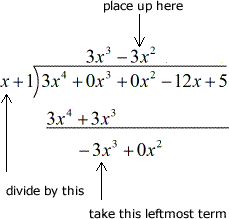
STEP 9: Multiply the answer you got previously, [latex] – 3{x^3}[/latex], and distribute into the divisor [latex]\left( {x + 1} \right)[/latex].
STEP 10: Place the answer below then perform subtraction.
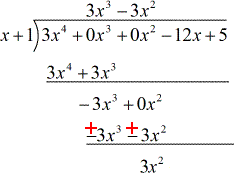
STEP 11: Bring down the next adjacent term of the dividend

STEP 12: Go up again by dividing the leading term below by the leading term of the divisor.
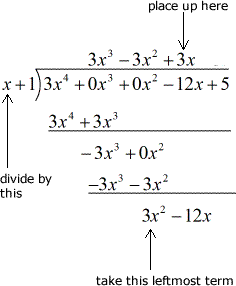
STEP 13: Go down by distributing the answer in partial quotient into the divisor, followed by subtraction.
I believe the pattern makes sense now. Yes?
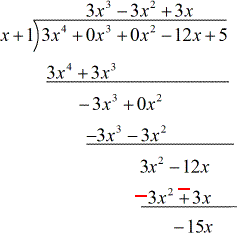
STEP 14: Carry down the last term of the dividend.
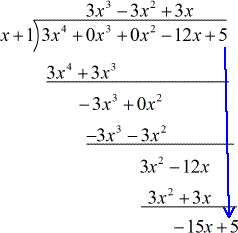
STEP 15: Go up again while performing division.
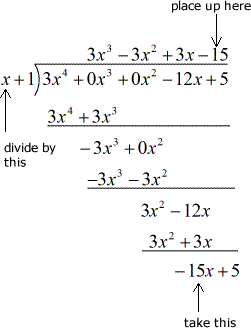
STEP 16: Go down again while performing multiplication.
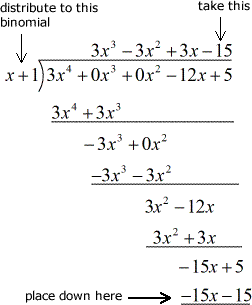
STEP 17: Do the final subtraction, and we are done! The remainder is equal to 20.
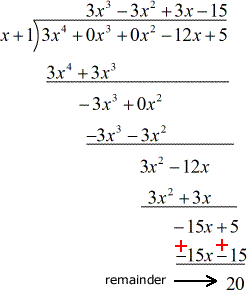
STEP 18: The final answer is


Example 4: Divide the given polynomial using the long division method

Solution: The dividend is obviously missing a lot of variable [latex]x[/latex]. That means I need to insert zero coefficients in every missing power of the variable.
I need to rewrite the problem this way to include all exponents of [latex]x[/latex] in descending order:

Remember the Main Steps in Long Division:
- When going up, we divide
- When going down, we distribute
- Subtract
- Carry down
- Repeat the process until done
Verify if the steps are being applied correctly in the example below.
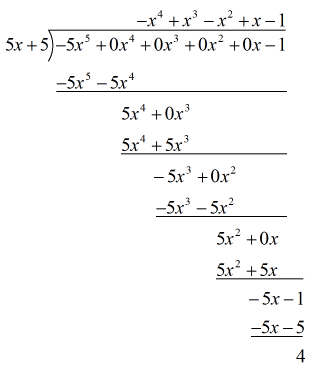
So the final answer is

Example 5: Divide the given polynomial using the long division method

Solution: We have a polynomial with five terms being divided by a trinomial. Both the dividend and divisor are in standard form, and all powers of the variable [latex]x[/latex] are present. This is wonderful because we can now start solving it.
The solution to this problem is presented in the animated picture. Observe each step carefully, and see if you can follow it.
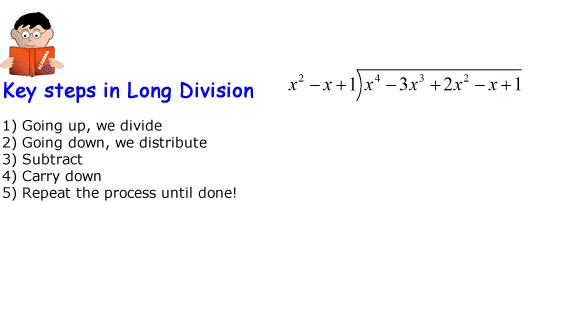
You may also be interested in these related math lessons or tutorials:
Adding and Subtracting Polynomials
Dividing Polynomials using Synthetic Division Method
Multiplying Binomials using FOIL Method
Multiplying Polynomials
